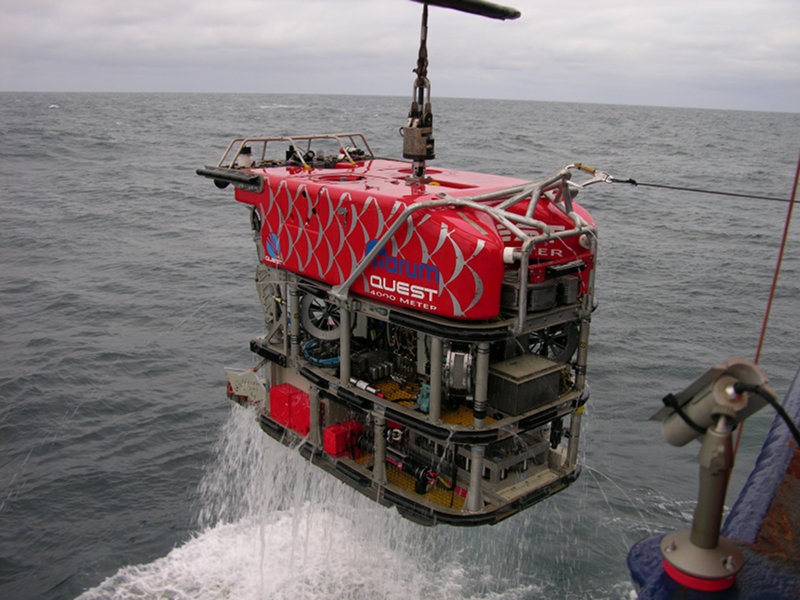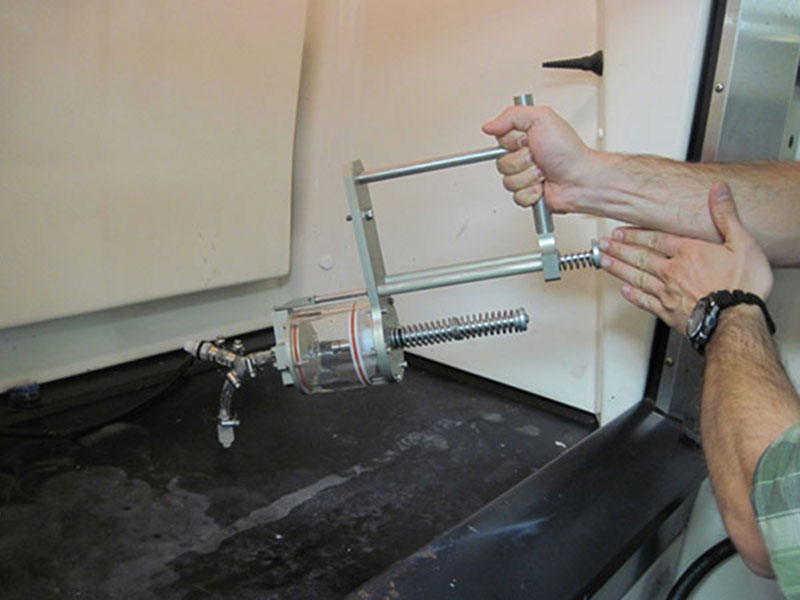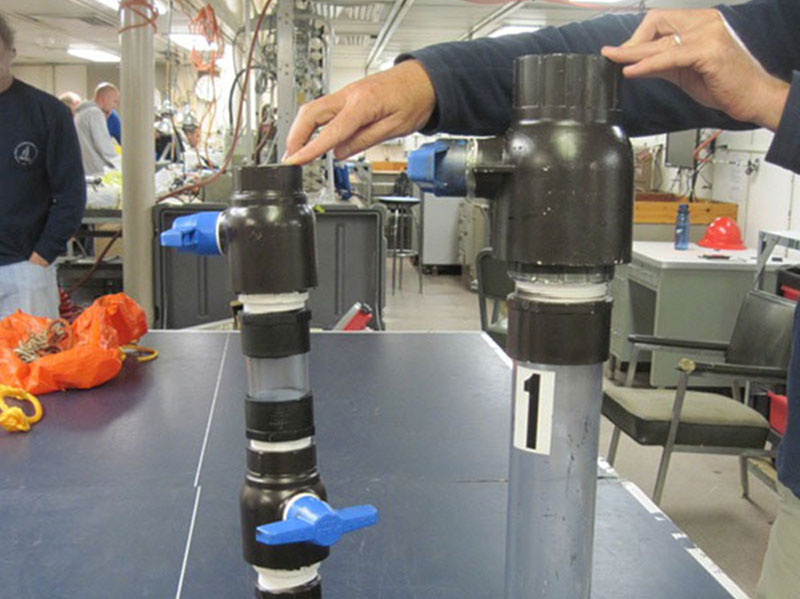
By Paula Keener, Marine Biologist - Director, Education Programs, NOAA Ocean Exploration & Research
September 10, 2012
0638 GMT
Wind – ESE @ 8 kts
Air Temperature – 21.2°C (70.2°F)
Sea State – 3.5m
The R/V Roger Revelle continued to steam toward its first exploration target, Vai Lili, to explore bacterial mats and collect water samples from hydrothermal vent sites found at this vent field located on the central Valu Fa Ridge in the Lau Basin. The Germany-based ROV Team continued to prepare the Quest 4000 for its first dive as scientists gathered in the ship’s hydrographic lab for a Science Mission Overview Meeting.

The University of Bremen-based Quest 4000 ROV team prepares the vehicle for its first dive. Image courtesy of Submarine Ring of Fire 2012: Northeast Lau Basin, NOAA-OER. Download larger version (jpg, 3.7 MB).
During the meeting, each of the proposed dive targets was briefly discussed. Each of the target sites is fascinating and all are quite different from each other. One is the largest known crater on the seafloor and others have tall black smoker chimneys. Some display diffuse venting of hydrothermal fluids from the seafloor while some were last seen actively erupting. Along with the overview of each exploration target, each exploration team’s sampling strategies were also reviewed. With geologists, microbiologists, marine biologists, chemists and other oceanographers onboard, conversations were rich with ideas of how to configure the small sample collection space on board the Quest 4000, and there was much conversation about where samples should be collected at the target sites. As one can only imagine, when given the opportunity to explore the most volcanically-active region of the planet with one ROV and limited bottom times at each of these diverse sites, samples – whether rock, gas, microbe, shrimp or water - become priceless as many scientists have worked their entire lives to have the chance to obtain them.
Most interoceanic arcs, such as the Tonga arc, experience extensional forces behind the arc which rift the overriding plate and produce small spreading centers similar to mid-ocean ridges. Our first dive site, Vai Lili, is located on a spreading center called the Valu Fa ridge. The group on board the R/V Roger Revelle led by Dr. Brad Tebo has been funded by the National Science Foundation to obtain samples of unusual microbial mats at this site using specialized samplers developed at his lab at the Oregon Health & Science University. These mats, discovered and initially sampled on two prior ROV dives, are unusually thick and contain alternating layers rich in iron and manganese. Brad and his team will use the material sampled here to look at the microbial community with new sophisticated genomic techniques.

These scoops will be held by the manipulator claw of Quest 4000 to scoop up bacterial mats at Vai Lili. Image courtesy of Submarine Ring of Fire 2012: Northeast Lau Basin, NOAA-OER. Download image (jpg, 62 KB).

Special syringe that will be held and triggered by the manipulator claw of Quest 4000 to collect sediment samples for microbes at Vai Lili. Image courtesy of Submarine Ring of Fire 2012: Northeast Lau Basin, NOAA-OER. Download image (jpg, 93 KB).
“Texas Scoops“ and “Double Scoops“ were prepared in advance for sampling bacterial mats at Vai Lili. These will be used to collect samples of manganese and iron oxide encrusted microbial mats from the vicinity of diffuse flowing hydrothermal vents in the area. The “scoops“ were sterilized by soaking in ethanol and then filled with sterile water. Both “scoops“ will be held by the manipulator claw of the ROV as it literally “scoops“ up samples of the bacterial mats. The Texas Scoops will be used to collect microbes for DNA. The DNA will be used to sequence genomes of microbes that have not previously been cultured. The “Double Scoop“ contains a fixative, called RNA Later ™ that will enable scientists to sequence the RNA as it was transcribed at the time of sampling. By comparing the DNA sequencing to the RNA sequencing, scientists will be able to determine which genes the microbes were actively using at the time of sampling.
Sediments will also be sampled at the site using special syringe samplers. The syringe samplers were assembled, seals tested for water tightness and the syringes then primed and sterilized. Two of the single-fire syringes will be deployed on the ROV to collect sediment. A total of 10 ml of the sediment will be frozen in glycerol and selected bacteria will be grown from it later as scientists specializing in drug discovery look for natural products produced by these bacteria that can be used in the production of pharmaceuticals.